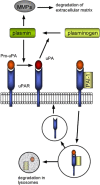Molecular aspects of tumour hypoxia
- PMID: 19383328
- PMCID: PMC5527797
- DOI: 10.1016/j.molonc.2008.03.006
Molecular aspects of tumour hypoxia
Abstract
Hypoxia is an important feature of the microenvironment of a wide range of solid tumours. Its critical role in radio- and chemoresistance and its significance as an adverse prognostic factor have been well established over the last decades. On a cellular level, hypoxia evokes a complex molecular response with a central role for the HIF-1 pathway. The cellular processes under control of HIF-1 contain important prognostic information and comprise potential candidates for directing hypoxia-modifying therapies. This review will provide an overview of the current knowledge on the molecular aspects of tumour hypoxia and the link to clinical practice.
Figures





References
-
- Airley, R. , Loncaster, J. , Davidson, S. , Bromley, M. , Roberts, S. , Patterson, A. , Hunter, R. , Stratford, I. , West, C. , 2001. Glucose transporter glut-1 expression correlates with tumor hypoxia and predicts metastasis-free survival in advanced carcinoma of the cervix. Clin. Cancer Res. 7, 928–934. - PubMed
-
- Airley, R.E. , Loncaster, J. , Raleigh, J.A. , Harris, A.L. , Davidson, S.E. , Hunter, R.D. , West, C.M. , Stratford, I.J. , 2003. GLUT-1 and CAIX as intrinsic markers of hypoxia in carcinoma of the cervix: relationship to pimonidazole binding. Int. J. Cancer 104, 85–91. - PubMed
-
- Baer, S. , Casaubon, L. , Schwartz, M.R. , Marcogliese, A. , Younes, M. , 2002. Glut3 expression in biopsy specimens of laryngeal carcinoma is associated with poor survival. The Laryngoscope 112, 393–396. - PubMed
-
- Bajou, K. , Masson, V. , Gerard, R.D. , Schmitt, P.M. , Albert, V. , Praus, M. , Lund, L.R. , Frandsen, T.L. , Brunner, N. , Dano, K. , 2001. The plasminogen activator inhibitor PAI-1 controls in vivo tumor vascularization by interaction with proteases, not vitronectin. Implications for antiangiogenic strategies. J. Cell Biol. 152, 777–784. - PMC - PubMed
-
- Beasley, N.J. , Leek, R. , Alam, M. , Turley, H. , Cox, G.J. , Gatter, K. , Millard, P. , Fuggle, S. , Harris, A.L. , 2002. Hypoxia-inducible factors HIF-1alpha and HIF-2alpha in head and neck cancer: relationship to tumor biology and treatment outcome in surgically resected patients. Cancer Res. 62, 2493–2497. - PubMed
Publication types
MeSH terms
Substances
LinkOut - more resources
Full Text Sources

